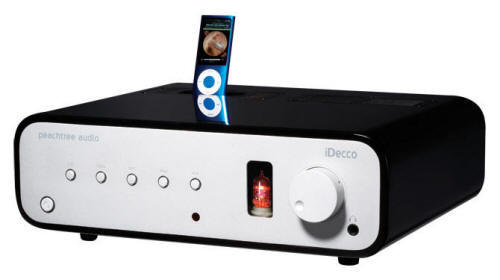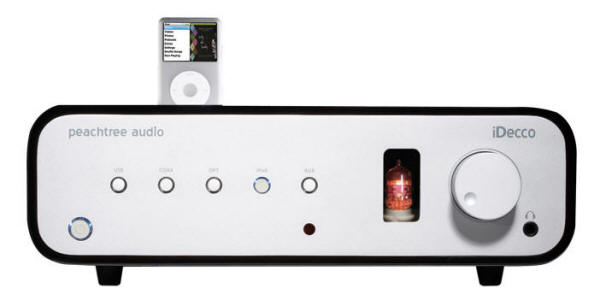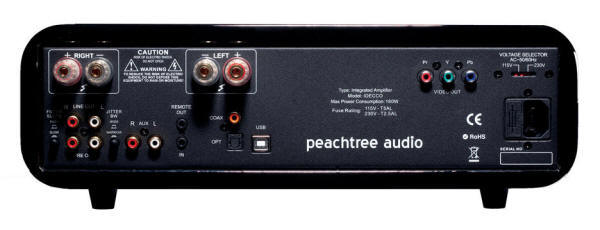|
You are reading the older HTML site Positive Feedback ISSUE 48march/april 2010
The Neoteric Listener...
and the Peachtree Audio iDecco integrated
Compact package, useful functions, great sound: "That is all/ Ye know on earth, and all ye need to know." So says the poet (kind of), but maybe you say "I need to know a lot more than that about the Peachtree Audio iDecco Gloss Black Integrated Amplifier." No problem, this amp is the talk of the town, and for good reason. Say, your face looks familiar... The iDecco follows on the phenomenal success of the Peachtree Audio Nova integrated, and shares much of the form and many of the functions of its much heralded predecessor. With its rounded corners, high gloss chassis and silver faceplate, the iDecco has the same dimensions as the Nova, but the reduced number of input selector buttons on the faceplate simplifies the design and adds to its visual charm. At CES 2010, Peachtree Audio's David Solomon spoke of the mild debate about whether or not to preserve the familiar Nova contours in the design of the iDecco, or to adopt a more traditional rectangular shape. When he would ask the invariably crowded room which shape they preferred, almost everyone chose the rounded design, and so do I. Also, like the Nova, there is a little tube in the fascia window (in this case, a Class A 6N1P tube) that lights up when the iDecco is used as a preamp, integrated amp, or headphone amp. Connections include USB, SP/DIF, Toslink, RCA analog and RCA component video—everything but an HDMI or water faucet—and there's a preamp and fixed line out. The amp utilizes a 40 watt MOSFET solid-state design, and features a fully functional remote that operates not only the amp but some features of a docked iPod, as well. Digital information is processed by a Sabre Premier Audio ES9006 DAC and passed through the 6N1P to give the sound a bit of tube warmth. The amp runs fairly cool, and has both a modern look and feel to it. For example, when switching inputs to a digital source, you can see a little blue light circling the input button as if "searching" for the signal. Most amps still clunk like the channel dial of a Philco TV when turning on the power, switching inputs, or even adjusting the volume. Making these adjustments with the iDecco, however, conveys the sense that something is thinking inside the machine and making sure that everything works according to Hoyle (or HAL?). The top synching iPod aperture requires some headroom in a rack, but that shouldn't be problem unless you're trying to wedge it on top of your cable box or something equally ridiculous. But don't get confused, Tony, this ain't no toy, this ain't no disco, and this sure ain't no foolin' around. This is an audiophile approved music maker that fits every space in the house, including the main listening room.
Fun function junction... We've all looked at cables, components, and audiophile debris encroaching on our living space and bank accounts and exclaimed, "Geez, I just wanted to play some music!" That doesn't mean we rush out and sell it all (although the cult of three watt amp and tiny monitor ascetics does seem to be growing) but there is definitely a market for a one stop music box, wrapped up nice and neat. The iDecco is amazingly well equipped to fill this role. For serious listening, I used one application at a time, but for the most part, I hooked up everything I could and used the remote to switch back and forth, as needed. Here's a rundown of how it all shaped up in my living room. The iPod played various playlists via the "Pure Digital" iPod dock. Unlike other idocks I have used, the iDecco bypasses the iPod's internal DAC completely, and only takes the iPod's digital signal ("pure ones and zeros" to quote David Solomon). The data stream is then sent to the Sabre's 96/24 upsampling DAC, and on through the tube buffer and finally to the amp. Although I enjoyed the iDecco DAC with my Arcam 82 CD player, I typically connected the Arcam via the analog input and used the digital connection with my blue ray player. Itune's lossless files and internet radio was streamed from my cheap IBM and then my not-so-cheap Mac Book Pro to the iDecco's USB port. The Peachtree Audio powered a variety of speakers (Clara Vu 7s, Tannoy Eyris 1s, and Nola Boxers) as well as a Velodyne Optimum 10 subwoofer, all without a hitch. Borrowing my brother's ragged pair of Grado headphones (my Koss pair having long wandered off during the murky 80s), I submerged myself into the audio ether. To recap, the iDecco's many abilities include: "Pure Digital" iPod Dock Integrated Amplifier Stand-Alone Multi-Input DAC Class A Headphone Amplifier And something I didn't experience personally, but definitely worth noting, Class A Tube Preamplifier Believe me, I had a ball tinkering with this and that and exploring all of the many nuances of this amp. You know what?... this amp is a lot of fun! I say this surreptitiously because high end audio is one of the few places where "fun" is often a pejorative and perceived sound quality is directly proportionate to the difficulty of actual use ("Oh we never use that line conditioner during this phase of the moon!) but , c'mon, who doesn't love a champion plate spinner? It won't be easy finding a product that serves so many useful functions at such a high level for anywhere near the $999 needed to put the iDecco in your rack. Still, it is easy to find a port-load of cargo ships filled with do-everything wonders with all the blissful sound of a Swiss army knife, so let's answer the pivotal question toot-sweet.
A five tool player is a rare commodity... I'm delighted to report that the iDecco produces really exceptional music, no matter which function you use. Please consider this positive first impression in light of the fact that this amp arrived right on the heals of the recently reviewed, and highly enjoyable, Mystere ia11. I should also point out that, due to several ill-timed furniture additions and even more ill-conceived "rearranging" by me, I'm currently engaged in a bitter battle with my room's acoustics. So, given the lingering echo of the Mystere and the shifting audio fog of my listening room (I ended up doing most critical listening in near-field), I knew I was sending the iDecco up to face a knuckleballer. Thus, when I turned it on for the first time, I wasn't prepared for my first words to be, "Wow, that is one sweet sounding amp!" But that's exactly what happened. This amp has tone, timing and detail that are immediately appreciable. I thoroughly enjoyed the iDecco's performance, as I found it to be excellent in almost every respect. Herby Hancock's "Blind Man, Blind Man" from his CD, My Point of View, for example, was expressed with a wide and natural soundstage, a naturally rendered guitar solo (always a litmus test for me), a fine retrieval of the softly muted piano chord accompaniment and standup bass, and a speedy capture of the tiny vibrations of the loose spring snare drum. While the Mystere may have had a more traditional tube amp "weight" to its overall sound, the iDecco has a shimmering vitality that continued to appeal throughout the months. Employing the digital connection to spin Elton John's "Captain Fantastic and the Brown Dirt Cowboys," CD, I observed that a sonic "film" was removed when playing the title track. The heightened resolution brought out the snarl of the of the Flying V's humbucker pickups and, less enjoyably, the dull thud of the untuned but brilliant Ludwig drums. The digital connection also worked quite well when playing the blu ray player. Watching the Oscar winning war pic, Hurt Locker, I noticed that the film's dialog (what little of it there was) was refreshingly intelligible, while mortars, screaming, and mayhem (what lot of it there was) turned my shack into a veritable war room. Mission accomplished, I guess, but I much preferred the iDecco's ability to enliven the Nola Boxers (review forthcoming) when watching the superb performances in Roy Orbison and Friends-Black and White Night. The lack of an hdmi connector (and the relatively modest wattage by AV amp standards) keeps the iDecco from being the consummate home theatre amp of choice, but its performance in a 3.1 setup was thrilling, nonetheless.
The iDecco is good enough that I could stop here and give it a solid recommendation, but that wouldn't quite dot the "i", because this amp really shows its quality when partnered with a n iPod or laptop. Personally, I found that expanding my music collection to world-wide proportions has allowed me exponentially increase the titles that adhere to the narrow prejudices I've acquired over a lifetime. I have the same broadly-narrow choice of genres, but the internet has enabled me to make substantially more additions to my hates and greats. Which suits me fine, see and I love my internet radio and high res purchases. Streaming internet radio, for example, has taught me that DJ/Remixer heavyweight Paul Oakenfield's "Starry Eyes Surprise" is one of those bass thumping chop suey remixes guaranteed to crowd the discoteer's dance floor and clear the audio show hotel room. Great for evaluating amplifier muscle, though, and the iDecco had little problem leg squatting OON-CHUG, OON-CHUG, OON-CHUG at the requisite uncomfortable volume level. Really! To be fair, at 40 watts, it's not going to have the control or sheer massiveness in the lower frequencies that could be obtained with a pair of monoblocks and a ton of watts, but the fact that it can be paired with those monoblocks as a preamp is a handy derringer in the boot. Anyway, it's more than enough to say that the clarity and resolution of its DAC when playing internet radio is amazing. I really like my Benchmark Devilsound DAC, and I had to go back and forth quite a few times before I could make a final determination. Still, it was quite apparent that the iDecco DAC outperformed the Devilsound in most areas. I should disclose that I almost, almost always prefer the sound of any respectable CD player to something emanating from a computer, and that includes five figure players/DACs and whatnot. I know the bit rate math bit, but I just like the sound of CDs, even if a little grain must fall. Records trump CDs, too, but that's another matter. Naturally, this gets me a lot of "What the devil's wrong with your ears?" comments from fellow audiophiles, but that's my peccadillo and I'm sticking to it. That is, until I made direct comparisons between a track being played on computer via the USB port, on the iPod dock, and on the CD player via the RCA connection. George Duke's "Look What We Started Now" is an audiophile standard, owing in no small part to its toenail rattling bass and because it's the centerfold of the "Get in a sexy mood, boo" playbook. Donning my midnight blue, music note pattern silk robe and noshing on pomegranate slices, I song-swapped until I could declare a winner. The show position went to the USB connection, but, again, this is a remarkably even, musical presentation that anyone who listens to it without direct comparison will think is top of the line. In the place position is the CD player which, while maybe a little more flawed sonically than the USB connection, had a more immediate and natural sound. Trumping the Arcam 82 CD player for a surprisingly unexpected first place was the iPod doc. Music jumped out of my speakers with a fullness and depth that is hard to describe. Lots of string snapping bass runs in this song, and the iPod doc gave even more heft and detail to the bottom rumble than the analog CD could muster. Maybe I was suckered in by the varying output level of each source, but I discerned a more distinct soundstage and imaging, too. Keyboards, guitar fills, and the occasional bell tones were also more convincing when played through the iPod (how many times have you ever read that sentence?). The point of all this is, of course, is that my Arcam 82 CD player cost about $1100 new, and the iDecco makes the purchase of a comparable CD player unnecessary, given a loaded iPod and plenty of lossless files. Truly a revelatory experience, and something that greatly adds to the cost benefit of the iDecco. I've often stated that I'm loathe to really crank up the volume, as I'm not fond of blowing out my ears or blowing up review products, so for the longest time I worried that the Peachtree would be underpowered for those times when I wanted things to really wail. Thankfully, when I finally summoned up the nerve to go to the badass side of dial, the volume was unquestionably loud for anyone not a Monsters of Metal sound tech, and the music was able to remain music until I really pushed it to forehead-to-stage edge levels. Leaving its noise making capabilities aside, one should also remember that the manufacturer's claim that the iDecco is a "world-class preamp" evokes the additional fun of pairing an amplifier or two for even more power and detail. In this way, the iDecco becomes even more future-proof, and can be part of an ever expanding an evolving system. Summing up... Both the Wadia 170i and the B&W Zeppelin mini offer the ability to bypass the iPod DAC, and both products cost about $400. The Devilsound DAC 2.1 is a fantastic bargain at $399. Don't even try to do the math to find the price of a comparable preamp, integrated amp, and headphone amp. I have interconnects in my system that cost more than the iDecco (more than two iDecci, even) and none of them make music so sweetly, or in such an entertaining fashion. This is a marvelous sounding integrated amplifier and a stupendous value. Very Highly Recommended.
iDecco Integrated Amplifier Signal Path International http://www.signalpathint.com/
|




